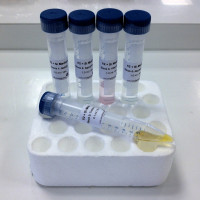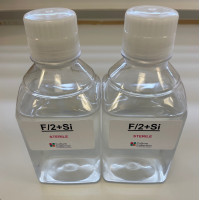References [ 25 ]
Day JG (1998) Cryo-conservation of microalgae and cyanobacteria. CryoLetters S1: 7-14.
DOI: none
De Martino A, Meichenin A, Shi J, Pan K & Bowler C (2007) Genetic and phenotypic characterization of Phaeodactylum tricornutum (Bacillariophyceae) accessions. Journal of Phycology 43: 992-1009.
Moniz MBJ & Kaczmarska I (2010) Barcoding of diatoms: Nuclear encoded ITS revisted. Protist 161: 7-34.
Clark DR, Merrett MJ & Flynn KJ (1999) Utilization of dissolved inorganic carbon (DIC) and the response of the marine flagellate Isochrysis galbana to carbon or nitrogen stress. New Phytologist 144: 463-470.
DOI: none
Chen X, Qiu CE & Shao JZ (2006) Evidence for K+-dependent HCO3- utilization in the marine diatom phaeodactylum tricornutum. Plant Physiology 141: 731-736.
DOI: none
Dixon GK & Merrett MJ (1988) Bicarbonate utilization by the marine diatom Phaeodactylum tricornutum Bohlin. New Phytologist 109: 47-51.
DOI: none
Iglesias-Rodriguez MD & Merrett MJ (1997) Dissolved inorganic carbon utilization and the development of extracellular carbonic anhydrase by the marine diatom Phaeodactylum tricornutum. New Phytologist 135: 163-168.
DOI: none
Clarkson N, Leftley JW, Meldrum DT & Watson JW (1998) An assessment of the cage-culture turbidostat as an alternative algal bioassay. Water Research 32: 1162-1168.
Molloy CJ & Syrett PJ (1988) Effect of light and N deprivation on inhibition of nitrate uptake by urea in microalgae. Journal of Experimental Marine Biology and Ecology 118: 97-101.
DOI: none
John-McKay ME & Colman B (1997) Variation in the occurrence of external carbonic anhydrase among strains of the marine diatom Phaeodactylum tricornutum (Bacillariophyceae). Journal of Phycology 33: 988-990.
DOI: none
Nimer NA, Iglesias-Rodriguez MD & Merrett MJ (1997) Bicarbonate utilization by marine phytoplankton species. Journal of Phycology 33: 625-631.
DOI: none
Lavaud J & Lepetit B (2013) An explanation for the inter-species variability of the photoprotective non-photochemical chlorophyll fluorescence quenching in diatoms. Biochimica & Biophysica Acta 1827: 294-302.
Wong DM & Franz AK (2013) A comparison of lipid storage in Phaeodactylum tricornutum and Tetraselmis suecica using laser scanning confocal microscopy. Journal of Microbiological Methods 95: 122-128.
McLellan MR (1989) Cryopreservation of diatoms. Diatom Research 4: 301-318.
He L, Han X & Yu Z (2014) A rare Phaeodactylum tricornutum cruciform morphotype: Culture conditions, transformation and unique fatty acid characteristics. PLoS ONE 9: e93922.
Schellenberger Costa B, Sachse M, Jungandreas A, Bartulos CR, Gruber A, Jakob T, Kroth PG & Wilhelm C (2013) Aureochrome 1a is involved in the photoacclimation of the diatom Phaeodactylum tricornutum. PLoS ONE 8(9): e74451.
Stanley MS & Callow JA (2007) Whole cell adhesion strength of morphotypes and isolates of Phaeodactylum tricornutum (Bacillariophyceae). European Journal of Phycology 42: 191-197.
Cannell RJP, Kellam SJ, Owsianka AM & Walker JM (1987) Microalgae and cyanobacteria as a source of glycosidase inhibitors. Journal of General Microbiology 133: 1701-1705.
Abe T, Tsuzuki M, Kadokami Y & Miyachi S (1988) Isolation and characterization of temperature-sensitive, high-CO2 requiring mutant of Anacystis nidulans R2 Plant & Cell Physiology 29: 1353-1360.
DOI: none
Buhmann MT, Schulze B, Förderer A, Schleheck D & Kroth PG (2016) Bacteria may induce the secretion of mucin-like proteins by the diatom Phaeodactylum tricornutum. Journal of Phycology 52: 463-474.
Shemesh Z, Leu S, Khozin-Goldberg I, Didi-Cohen S, Zarka A & Boussiba S (2016) Inducible expression of Haematococcus oil globule protein in the diatom Phaeodactylum tricornutum: Association with lipid droplets and enhancement of TAG accumulation under nitrogen starvation. Algal Research 18: 321-331.
Lepetit B, Gélin G, Lepetit M, Sturm S, Vugrinec S, Rogato A, Kroth PG, Falciatore A & Lavaud J (2017) The diatom Phaeodactylum tricornutum adjusts nonphotochemical fluorescence quenching capacity in response to dynamic light via fine-tuned Lhcx and xanthophyll cycle pigment synthesis New Phytologist 214: 205-218.
Butler T, Kapoore RV & Vaidyanathan S (2020) Phaeodactylum tricornutum: A diatom cell factory Trends in Biotechnology -: -.
Song Z, Lye GJ & Parker BM (2020) Morphological and biochemical changes in Phaeodactylum tricornutum triggered by culture media: Implications for industrial exploitation Algal Research 47: 101822.
Beirne N, Edmundson S, Gao S, Freeman J & Huesemann M (2023) A streamlined approach to characterize microalgae strains for biomass productivity under dynamic climate simulation conditions Algal Research 72: 103099.





